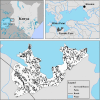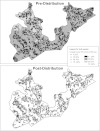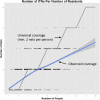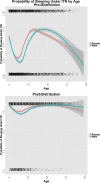Insecticide-treated net use before and after mass distribution in a fishing community along Lake Victoria, Kenya: successes and unavoidable pitfalls
- PMID: 25431086
- PMCID: PMC4289357
- DOI: 10.1186/1475-2875-13-466
Insecticide-treated net use before and after mass distribution in a fishing community along Lake Victoria, Kenya: successes and unavoidable pitfalls
Abstract
Background: Insecticide-treated nets (ITNs) have proven instrumental in the successful reduction of malaria incidence in holoendemic regions during the past decade. As distribution of ITNs throughout sub-Saharan Africa (SSA) is being scaled up, maintaining maximal levels of coverage will be necessary to sustain current gains. The effectiveness of mass distribution of ITNs, requires careful analysis of successes and failures if impacts are to be sustained over the long term.
Methods: Mass distribution of ITNs to a rural Kenyan community along Lake Victoria was performed in early 2011. Surveyors collected data on ITN use both before and one year following this distribution. At both times, household representatives were asked to provide a complete accounting of ITNs within the dwelling, the location of each net, and the ages and genders of each person who slept under that net the previous night. Other data on household material possessions, education levels and occupations were recorded. Information on malaria preventative factors such as ceiling nets and indoor residual spraying was noted. Basic information on malaria knowledge and health-seeking behaviours was also collected. Patterns of ITN use before and one year following net distribution were compared using spatial and multi-variable statistical methods. Associations of ITN use with various individual, household, demographic and malaria related factors were tested using logistic regression.
Results: After infancy (<1 year), ITN use sharply declined until the late teenage years then began to rise again, plateauing at 30 years of age. Males were less likely to use ITNs than females. Prior to distribution, socio-economic factors such as parental education and occupation were associated with ITN use. Following distribution, ITN use was similar across social groups. Household factors such as availability of nets and sleeping arrangements still reduced consistent net use, however.
Conclusions: Comprehensive, direct-to-household, mass distribution of ITNs was effective in rapidly scaling up coverage, with use being maintained at a high level at least one year following the intervention. Free distribution of ITNs through direct-to-household distribution method can eliminate important constraints in determining consistent ITN use, thus enhancing the sustainability of effective intervention campaigns.
Figures





Similar articles
-
Age and gender trends in insecticide-treated net use in sub-Saharan Africa: a multi-country analysis.Malar J. 2018 Nov 14;17(1):423. doi: 10.1186/s12936-018-2575-z. Malar J. 2018. PMID: 30428916 Free PMC article.
-
Evaluation of universal coverage of insecticide-treated nets in western Kenya: field surveys.Malar J. 2014 Sep 3;13:351. doi: 10.1186/1475-2875-13-351. Malar J. 2014. PMID: 25187326 Free PMC article.
-
Sustained high coverage of insecticide-treated bednets through combined Catch-up and Keep-up strategies.Trop Med Int Health. 2007 Jul;12(7):815-22. doi: 10.1111/j.1365-3156.2007.01862.x. Trop Med Int Health. 2007. PMID: 17596247
-
Estimating the number of insecticide-treated nets required by African households to reach continent-wide malaria coverage targets.JAMA. 2007 May 23;297(20):2241-50. doi: 10.1001/jama.297.20.2241. JAMA. 2007. PMID: 17519414 Review.
-
Ownership and use of insecticide-treated nets during pregnancy in sub-Saharan Africa: a review.Malar J. 2013 Aug 1;12:268. doi: 10.1186/1475-2875-12-268. Malar J. 2013. PMID: 23914731 Free PMC article. Review.
Cited by
-
A Longitudinal Analysis of Mosquito Net Ownership and Use in an Indigenous Batwa Population after a Targeted Distribution.PLoS One. 2016 May 4;11(5):e0154808. doi: 10.1371/journal.pone.0154808. eCollection 2016. PLoS One. 2016. PMID: 27145034 Free PMC article.
-
Risk Factors Associated with Diarrheal Episodes in an Agricultural Community in Nam Dinh Province, Vietnam: A Prospective Cohort Study.Int J Environ Res Public Health. 2022 Feb 21;19(4):2456. doi: 10.3390/ijerph19042456. Int J Environ Res Public Health. 2022. PMID: 35206644 Free PMC article.
-
Factors associated with caregivers' consistency of use of bed nets in Nigeria: a multilevel multinomial analysis of survey data.Malar J. 2018 Aug 2;17(1):280. doi: 10.1186/s12936-018-2427-x. Malar J. 2018. PMID: 30071875 Free PMC article.
-
Dynamic modelling of personal protection control strategies for vector-borne disease limits the role of diversity amplification.J R Soc Interface. 2018 Aug;15(145):20180166. doi: 10.1098/rsif.2018.0166. J R Soc Interface. 2018. PMID: 30135260 Free PMC article.
-
Ideational factors associated with consistent use of insecticide-treated nets: a multi-country, multilevel analysis.Malar J. 2022 Dec 6;21(1):374. doi: 10.1186/s12936-022-04384-3. Malar J. 2022. PMID: 36474206 Free PMC article.
References
-
- Lengeler C. Cochrane Database Syst Rev. 2004. Insecticide-treated bed nets and curtains for preventing malaria; p. CD000363. - PubMed
-
- Lim SS, Fullman N, Stokes A, Ravishankar N, Masiye F, Murray CJL, Gakidou E. Net benefits: a multicountry analysis of observational data examining associations between insecticide-treated mosquito nets and health outcomes. PLoS Med. 2011;8:e1001091. doi: 10.1371/journal.pmed.1001091. - DOI - PMC - PubMed
-
- WHO . Insecticide-Treated Mosquito Net: a WHO Position Statement. Geneva: World Health Organization; 2007.
-
- Bayoh MN, Mathias DK, Odiere MR, Mutuku FM, Kamau L, Gimnig JE, Vulule JM, Hawley WA, Hamel MJ, Walker ED. Anopheles gambiae: historical population decline associated with regional distribution of insecticide-treated bed nets in western Nyanza Province, Kenya. Malar J. 2010;9:62. doi: 10.1186/1475-2875-9-62. - DOI - PMC - PubMed
Publication types
MeSH terms
LinkOut - more resources
Full Text Sources
Other Literature Sources
Medical
Research Materials
Miscellaneous

